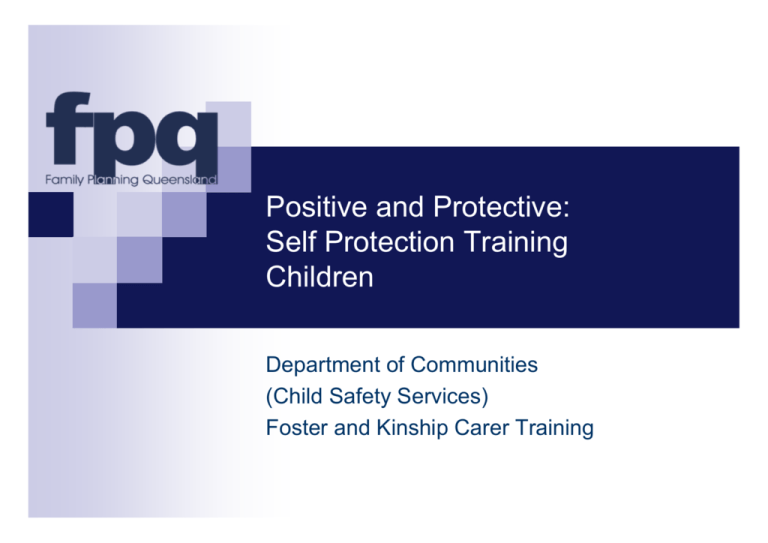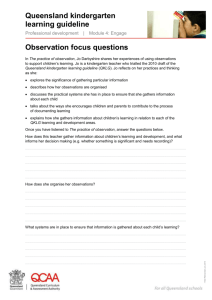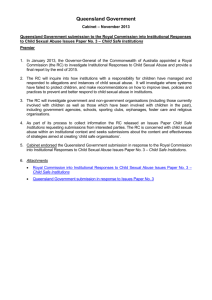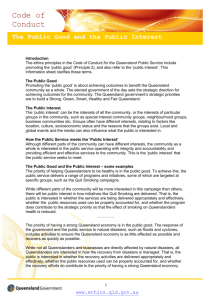
Positive and Protective:
Self Protection Training
Children
Department of Communities
(Child Safety Services)
Foster and Kinship Carer Training
Workshop outline
Time
Activity
10 min
5 min
10 min
5 min
20 min
20 min
Introduction
Defining Sexuality
Rationale for Self Protection Strategies
Sexual Assault
Reducing the Risk
Learning about Self Protection
Break
Break
20 min
20 min
20 min
15 min
5 min
Body Parts & Being Private
Feelings and Warning Signs
Relationships & Touch
Getting Help and Feeling Safe
Conclusion
© Family Planning Queensland 2010
What is sexuality
“Sexuality is an integral part of life and it influences
personality. It may be denied, repressed or used effectively
but it is part of our selves. Sexuality is a process
commencing at birth and ending only with death ...
Sexuality is culturally defined and thus influenced by family,
peers, religion, economics, school, media, law and
science.”
The Clarity Collective
The Clarity Collective.(1990).Taught Not Caught:Self Esteem in Sex Education.
Melbourne: Spiral Educational Resources.
© Family Planning Queensland 2010
Sexuality components
Spiritual
Religion
Feelings
Values
Beliefs
Physical
Reproduction
Birth control
Pregnancy
Sexual response
Growth and development
Body image
© Family Planning Queensland 2010
Social
Personal background
Friendships
Marriage/partnerships
Culture
Legal aspects
Emotional
Learned behaviour
Attitudes
Education
Expression
Feelings
Greenberg, Bruess, & Mullen (1992)
Sex is what we do.
Sexuality is who we are.
Anna Freud
Daughter of Sigmund and Martha Freud, 1895-1982
© Family Planning Queensland 2010
Social learning
Sexuality is a gradual process of learning and development
which occurs in the context of society and culture.
Society
School
Peers
Family
Child
© Family Planning Queensland 2010
6
Rationale for self protection education
•
Children who have been sexually abused are more
vulnerable to further sexual abuse or exploitation. (Forde Inquiry.
1999)
•
Research suggests that perpetrators of sexual abuse are
less likely to choose victims who demonstrate knowledge
of self protection skills. (Daro, 1991 cited in O’Connor, 1991)
•
Children in care are less likely to access school sexuality
education programs and are less likely to have the same
sexuality knowledge of their peers – therefore have a high
need for sexuality education. (Brennan, 2008)
© Family Planning Queensland 2010
Benefits of self protection education
The benefits of receiving positive, factual, consistent messages and
information about self protection include:
•
•
•
•
•
•
the development of a safety network of trusted adults to talk to
increased communication skills to talk about bodies
an understanding of healthy, respectful relationships
learning to identify and express their own personal boundaries
knowledge to identify abusive situations
less likely to experience sexual abuse
© Family Planning Queensland 2010
What is sexual abuse?
Any sexual activity between an adult and a child below the age of consent or nonconsensual activity between minors, including:
Kissing or holding a child in a sexual manner
‘Flashing’ or exposing a sexual body part to a child
‘Spying’ on children in bathrooms or bedrooms etc
Speaking to children about sexual matters
Obscene phones calls, remarks or emails to a child or young person
Fondling of a child or young person’s body in a sexual manner
Persistent intrusion into a child’s privacy
Penetration of the vagina or anus by a finger, penis or any other object
Showing pornographic films, magazines or photographs to a child
Oral sex
Rape
Incest
Having a child pose or perform in a sexual manner
Forcing a child to watch a sexual act and/or child prostitution.
Practice paper: Child Sexual Abuse (from Child Safety Practice Manual)
© Family Planning Queensland 2010
Indicators of sexual abuse
1.
Verbal disclosures
2.
Sexual behaviour that is persistent, not age appropriate, and
appears to be compulsive
3.
Sexual themes in art, stories and play
4.
Hurting self and/or others, aggression
5.
Sleep disturbances, nightmares, bed wetting
6.
Changes in appetite
7.
Excessive compliance
8.
Disassociation
9.
Display of compulsive behaviours
© Family Planning Queensland 2010
…..continued
Indicators of sexual abuse
10. Hyper-arousal / heightened anxiety
11. Other signs of trauma, such as responding to specific triggers,
changes in body language when anxious, inability to regulate
emotions, etc.
12. Pain, itching, infection, bleeding or bruising in genital/anal area
13. Bruising on arms, thighs
14. Refusing to undress, wash or bathe, or often wearing layers of
clothing
15. Changes in relationships, including jealousy, over-protectiveness, or
fear
16. Withdrawal, depression, self-harm, suicidal feelings or attempts
© Family Planning Queensland 2010
Sexual abuse
• no clear stats for children and young people in care but it is
believed they are at greater risk
• mainstream stats: one in three girls and one in seven boys
• people with disabilities are 3 to 7 times more likely to be a
victim of sexual abuse
• 1 in 7 children aged 10-17years will receive a sexual
invitation from a stranger over the internet
ABS, (2006), CMC, (2004), Edmond et al (2002),
Finkelhor, Mitchell & Wolak (2006) NCB, (2005), Leslie et al, (2004).
© Family Planning Queensland 2010
Substantiations of abuse
AIHW (2009, p. 69)
Percentage breakdown of primary substantiated
maltreatment types in Australia in 2007–08
© Family Planning Queensland 2010
Bromfield and Irenyi (2009)
Amount of substantiations of notifications
• Children less than 1 year old are most likely to be the subject
of a substantiation
• Followed by the age group of 1-4 years old
• Young people aged 15-16 years old are the least likely to be
the subject of a substantiation
AIHW Child Protection Collections 2009
© Family Planning Queensland 2010
Responding to a disclosure
•
Believe the child
•
Reassure the child; do not “shame” or “blame”
•
Listen and encourage the child to talk, but do not investigate
•
Be sensitive and supportive
•
Don’t make promises you can’t keep
•
Follow policy and guidelines in recording and reporting
•
Document in writing as soon as possible
•
Find supports available
© Family Planning Queensland 2010
What are self protection skills?
•
Naming private body parts
•
Naming and identifying feelings
•
Understanding types of relationships
•
Knowing the rules about touch
•
Recognising warning signs
•
Awareness of No Go Tell strategies
•
Identifying support networks
© Family Planning Queensland 2010
Why talk about bodies?
•
Knowledge of correct/scientific names
•
Ability to identify and name body parts
•
Normalising private body parts
•
Knowledge of functions of body parts
•
Positive feelings about body, body image, self-esteem
•
Opportunity to ask questions
•
Reinforce rules about privacy
•
Part of a self-protection program
© Family Planning Queensland 2010
I have the right to be safe p2
© Family Planning Queensland 2010
Language of sexuality
• Scientific
designed for precision, eg, cervix, coitus
• Childhood
designed to hide embarrassment and avoid
confrontation, eg, number 2, wee-wee
• Common discourse
designed to communicate information plainly,
eg, making love, having sex
• Slang
describing vigorously and sometimes demeaningly,
eg, fuck, cock, slut, wanker
© Family Planning Queensland 2010
Public sign
© Family Planning Queensland 2010
Private sign
© Family Planning Queensland 2010
Why talk about relationships and touch?
To learn about:
•
Types of relationships
•
Activities within relationships
•
Emotions in relationships
•
Types of touch
•
Boundaries about touch and with whom
•
Establishing and maintaining healthy relationships
•
Staying safe in relationships
© Family Planning Queensland 2010
I have the right to be safe p3
© Family Planning Queensland 2010
I have the right to be safe p4
© Family Planning Queensland 2010
Why talk about different feelings?
• To recognise how each feeling looks or feels
• To tell someone about many feelings, not just scared
feelings. Sexual abuse doesn’t always feel unwanted or
scary
• To identify the appropriate people to talk to about different
types of feelings
• To understand what it feels like to be safe
© Family Planning Queensland 2010
I have the right to be safe p1
© Family Planning Queensland 2010
Feelings shield
Glue or draw feelings on the shield.
Happy
Sad
Angry
Scared
Sexy
Jealous
Every Body Needs To Know © 2007 Family
Planning Queensland
© Family Planning Queensland 2010
Feelings faces
Cut out the feelings to glue on the Feelings shield worksheet
Angry
Sexy
© Family Planning Queensland 2010
Scared
Jealous
Sad
Happy
Every Body Needs To Know © 2007 Family
Planning Queensland
Party
© Family Planning Queensland 2010
Spider
© Family Planning Queensland 2010
© Family Planning Queensland 2010
© Family Planning Queensland 2010
© Family Planning Queensland 2010
© Family Planning Queensland 2010
© Family Planning Queensland 2010
© Family Planning Queensland 2010
Why teach problem solving?
• To encourage early disclosure from children as sexual
abuse often involves a prolonged grooming process by a
perpetrator.
• Often programs do not teach children the skills to resist
grooming.
• Teaching problem solving skills and making choices gives
children options before abuse progresses to a more serious
level.
© Family Planning Queensland 2010
Sanderson, J. (2004). Child Focused Sexual Abuse Prevention Programs. Research & Issues
Paper Series. No 5Jun 2004. Crime and Misconduct Commission Queensland.
Why teach problem solving?
• Children with education and skills in problem solving are more
likely to disclose incidents and seek help than children without
these skills.
• Compared with girls, boys have poorer problem solving skills
when they are presented with sexual dilemmas.
• Boys prefer techniques not usually taught in prevention
programs and don’t often employ the problem solving skills
provided.
© Family Planning Queensland 2010
.
Sanderson, J. (2004). Child Focused Sexual Abuse Prevention Programs. Research & Issues
Paper Series. No 5Jun 2004. Crime and Misconduct Commission Queensland.
I have the right to be safe p5
© Family Planning Queensland 2010
I have the right to be safe p6
© Family Planning Queensland 2010
Support strategies for children
• Make time to talk
• Make time to listen
• Acknowledge feelings
• Believe in and respect the child
• Teach self protection skills
• Know your referral list
© Family Planning Queensland 2010
Looking after yourself – it’s important!
• Be aware of your stressors or triggers
• Attend to physical, emotional, spiritual, creative, and
interpersonal well-being
• Seek personal counselling/therapy
• Nurture yourself
• Seek balance between work, rest and play
• Maintain meaning and connection, with yourself, family,
friends, and others
© Family Planning Queensland 2010
Bibliography
Australian Institute of Health and Welfare 2010. Child Protection Australia 2008-09. Child welfare series no. 47. Cat. No. CWS 35.
Canberra: AIHW
Australian Institute of Health and Welfare 2005. Child Protection Australia 2003 –04: Child welfare series no. 36. Canberra: AIHW
Berlyn, C. & Bromfield, L. (2009) Child protection and Aboriginal and Torres Strait Islander Children National Child Protection
Clearinghouse, Australian Institute of Family Studies
Brennan, H (2008). Settings and Solutions: Supporting access to sexuality and relationship information for children in care.
Brisbane: Family Planning Queensland.
The Clarity Collective. (1990).Taught Not Caught: Self Esteem in Sex Education. Melbourne: Spiral Educational Resources.
Crime and Misconduct Commission Queensland. (2004). Protecting Children: An Inquiry into the Abuse of Children in Foster Care.
Brisbane: Crime and Misconduct Commission Queensland.
Family Planning South Australia, Intellectual Disability Services Council South Australia & Child and Youth Health. (1996). A Family
Approach to Protective Behaviours: For Children with Special Needs. Adelaide: Family Planning South Australia Inc.
Finkelhor, D., Asdigian, N. & Dziuba-Leatherman, J. (1995). The Effectiveness of Victimization Prevention Instruction: An evaluation of
Children’s Responses to Actual Threats and Assaults. Child Abuse and Neglect, 19, 2, 141 –153.
Fleming, J. (1997). Prevalence of Childhood Sexual Abuse in a Community Sample of Australian Women. Medical Journal of
Australia. Vol 166, No. 2 (20 Jan) pp65-68.
FPQ. (2001). Every Body Needs to Know: A sexual and reproductive health resource for teaching people with a disability. Brisbane:
Family Planning Queensland.
FPQ. (2002). Feel Safe: An educational CD Rom promoting self protection for young people with learning needs. Brisbane: Family
Planning Queensland.
© Family Planning Queensland 2010
Bibliography
Bromfield, L & Irenyi, M (2009) Child abuse and neglect statistics. National Child Protection Clearing House resource sheet: Australian
Institute of Family Studies
FPQ. (2003). I have the right to be safe: Flip Chart. Brisbane: Family Planning Queensland.
FPQ. (undated). Support for Women: Cairns Sexual Assault Service brochure. Brisbane: Family Planning Queensland.
FPQ (2007) Bodies and Relationships Essentials Education. Brisbane: Family Planning Queensland
FPQ. (2009). Where Do I Start: Supporting healthy sexual development in early childhood. Brisbane: Family Planning Queensland.
Finkelhor D, Mitchell K, Wolak J (2006) Online Victimization of Youth: five years later. Crimes against children research centre
University of new Hampshire
Greenberg, J., Bruess, C. and Coonley, K. (1992). Sexuality: Insights and Issues. USA: McGraw and Hill.
Gilgun, J.F. (1986). Sexually abused girls’ knowledge about sexual abuse and sexuality. Journal of Interpersonal Violence, 1, 3, 309 –
325.
Legosz, M.L. (2001). The childhood and adult sexual abuse experiences of women who attend a family planning clinic. Queensland:
Queensland University of Technology.
Melican, B. (1994). Power Source: A user’s guide to the Protective Behaviours Programme. Victoria Police, Australia.
O’Connor, R. (1991). Working Paper 16: Child sexual abuse: Treatment, prevention and detection. Victoria: Centre for Health Program
Evaluation
Queensland Crime Commission and Queensland Police Service. (2000) Project Axis: Child Abuse in Queensland: The Nature and
Extent. Brisbane: Queensland Crime Commission.
© Family Planning Queensland 2010
Bibliography
Rowley, T. (2007) Everyone’s Got A Bottom. Brisbane: Family Planning Queensland
Sanderson, J. (2004). Child-focused sexual abuse prevention programs. Research & Issues Paper Series. No. 5 June 2004. Crime
and Misconduct Commission Queensland.
Secretariat National Aboriginal and Islander Child Care. (2002). Through Young Black Eyes: A handbook to protect indigenous
children from the impact of family violence and child abuse. Northcote: SNAICC.
Smallbone and Wortley cited in Queensland Crime Commission and Queensland Police Service. (2000) Project Axis: Child Abuse in
Queensland: The Nature and Extent. Brisbane: Queensland Crime Commission.
Sobsey, D. (1994). Violence and Abuse in the Lives of People with Disabilities. Baltimore: Paul H. Brookes Publishing Co.
Sobsey, D. & Doe, T. (1991). Patterns of Sexual Abuse and Assault. Journal of Sexuality & Disability, 9(3), 243-259.
Sorenson, R. & Snow, B (1991). How Children Tell: The Process of Disclosure in Child Sexual Abuse. Child Welfare.
Vol 70, No. 1 (Jan-Feb) pp3-15.
Warden, D. (1996) The prevention of child sexual abuse. Child Safety: Problem and Prevention from Preschool to Adolescence.
London: Routledge.
© Family Planning Queensland 2010








